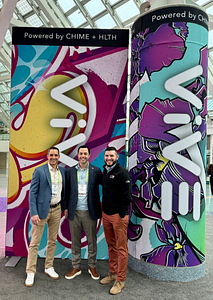The Innovator Spotlight Series features thought-provoking discussions highlighting diverse areas of healthcare innovation. Today’s focus we are continuing our conversation around how to address the opioid epidemic.
Addiction to opioids has long been considered a national crisis, with an estimated annual US economic burden of more than $504 billion1. While we have seen progress with regards to opioid safety and treatment options, including over the counter distribution of Naloxone, we still have a long way to go.
Earlier this month we dove into how two different health systems, MetroHealth System and Emory Healthcare, are transforming the way they provide care and partner with the community to combat the opioid epidemic. While health systems have predominantly focused their efforts on downstream fatality prevention and psychiatric implications, new emerging technologies show promise to not only optimize current efforts but move further upstream to minimize risk of misuse in the first place.
One interesting example of this is Carenostics and their research collaboration with the Veterans Administration Pittsburgh Healthcare System (VAPHS) to optimize and personalize treatments for Opioid Use Disorder (OUD) with US Veterans. Carenostics, which has developed a Machine Learning (ML)-driven platform to tackle underdiagnosis, undertreatment, and health inequities of chronic diseases, recently expanded from focusing on chronic kidney disease to Opiate use disorders (OUD). Their solution integrates with provider electronic health records (EHR) data and is built for, and tailored to each individual health system, enabling clinical decision support development for a given provider as opposed to universal support for a given disease state. Their model is well suited for OUD given the significant disparities and factors associated with OUD across populations.
The research at VAPHS in which Carenostics participates was funded by the Mental Illness Research Education and Clinical Center (MIRECC) at VAPHS. It was birthed out of true demand, as the opioid epidemic has disproportionately affected military personnel and Veterans. The ML solution uses 23 years of treatment data and over 10k anonymized records of patient treatment sessions to help identify the optimal treatment options for individual patients. In VAPHS EHRs, alerts can be provided for clinicians to either test, diagnose, treat, or refer an at-risk patient. Treatment histories and compliance information for both opioids and orthogonal treatments live directly in the patient record, making it an incredibly valuable source of information on its own.
“While social determinants of Health (SDoH) and external data may often be the most predictive data points when it comes to opioid exposure, especially with the veteran population, there is richness within the EHR if you know how to extract the right features.” – Kanishka Rao, COO and Cofounder at Carenostics
While still in the early days, this collaboration with the VAPHS shows promise to Veterans. With a robust portfolio of wrap-around services, the VAPHS is able to leverage Carenostics’ clinical decision support to connect patients with optimal, comprehensive care.
As we wrap our series, it is evident that the fight against opioid addiction requires a multi-faceted approach that combines technological innovation, health system transformation, and community collaboration. The strides made by organizations like Carenostics in collaboration with the VAPHS exemplify the potential of AI-driven solutions to revolutionize the treatment landscape for OUD. However, it’s essential to acknowledge that we are at the dawn of this transformative journey. Exploration of the early successes of such collaborations highlights the potential for machine learning and emerging technology to usher in a proactive era in managing OUD. By shifting the focus from reactive interventions to early detection and prevention, we have an opportunity to reduce overdose recurrence rates and truly make a lasting impact on this pervasive public health issue. As we embrace the evolving landscape and applications of healthcare technology, one constant remains — the pivotal role of community and cross-industry partnerships. Together, we can navigate the complexities of opioid addiction, offering support, understanding, and hope to those affected while working collectively towards a future free from the shackles of this enduring crisis.
Let’s connect!
Are you interested in discussing opioid safety programs? Are you a clinician on the front lines? If so, what have you witnessed? What are your challenges and successes? Reach out to talk more.
If you missed the first two parts of this series, check out our conversations with MetroHealth System’s Office of Opioid Safety and with Emory Healthcare’s Addiction Services and the Addiction Alliance of Georgia.


